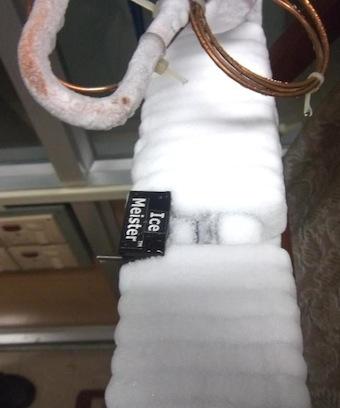Now You Know What Rime Ice Is
September 14, 2011

A release hit my inbox with the title "Optical Refrigerator Defrost Controller Promises Energy Savings for Supermarkets." Although I don't write about supermarkets, the use of an optical sensor to help save energy sounded interesting.
Since 1996, New Avionics has produced high-end ice sensors for specialized applications in aircraft and wind turbines. Now it has a "cool" sensor that uses the optical properties of ice to detect when it builds up on refrigerator coils. Dick Hackmeister, vice president at New Avionics, said the sensor detects changes in the refractive index of materials in a light path, and it can discriminate between clear ice (think of ice cubes) and rime ice, the frosty stuff that forms on ice cream containers and ice cube trays.
This image shows a sensor as it would mount on an arrangement of cooling tubes. It also shows how much rime ice could accumulate on the tubes without a controlled heating cycle.

The Ice*Meister shines a beam of light across a refrigerator tube to detect the optical properties of moisture and ice on the tube's surface.
Rime ice forms when super-cooled water droplets suspended in air fall on a surface, such as a refrigerator coil, and it creates an insulator that decreases cooling efficiency. Each time you open a refrigerated compartment, a new volume of air and water vapor enters and adds to the rime ice. Many appliances use a simple timer to cycle through an automatic defrost cycle that heats the refrigeration coils enough to sublime the rime ice. But heated refrigeration coils on a timer use energy inefficiently.
The Ice*Meister Model 9734-REFR Optical Defrost Controller detects a buildup of rime ice and turns on the defrost cycle only when needed. The sensor, which mounts directly on a cooling tube, can reduce a large refrigerator's power use by as much as 30 percent, according to Hackmeister. His company specifically aims to help companies that manufacture commercial walk-in refrigerators, reach-in refrigerated display cases, and similar self-defrosting chiller systems that can use a lot of electricity.
Say a kilowatt-hour of electrical energy costs $0.12 for a commercial reach-in refrigerated display case that consumes 2 kilowatts an hour and runs 16 hours a day, 300 days a year. The annual energy consumption comes to 9,600kW, so a 30 percent cost reduction amounts to about $345. Even with smaller savings, the sensor would pay for itself, since it costs $300 in quantity.
Because the Ice*Meister sensor detects ice, it also detects the absence of ice, and it can turn off a refrigerator heater as soon as the rime ice disappears. Thus, in addition to starting a defrost cycle only when needed, the sensor limits the heating cycle to only the time needed to remove the ice. To me, this sounds like an innovative approach to solving an energy-use problem with interesting sensor technology. Hackmeister explained that the technique uses basic high school physics, but someone had to think of how to apply that science to a problem and solve it.
We have a lot of room for other energy-saving sensors and controllers, some of which also will apply basic physics or chemistry. The trick comes in finding the root cause of wasted energy and the proper way to reduce it. Sometimes we look an an interesting device and say, "Why didn't I think of that?" That happened this morning when I read the New Avionics information.
About the Author(s)
You May Also Like



